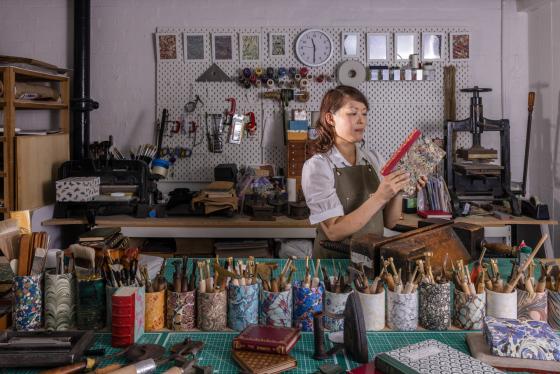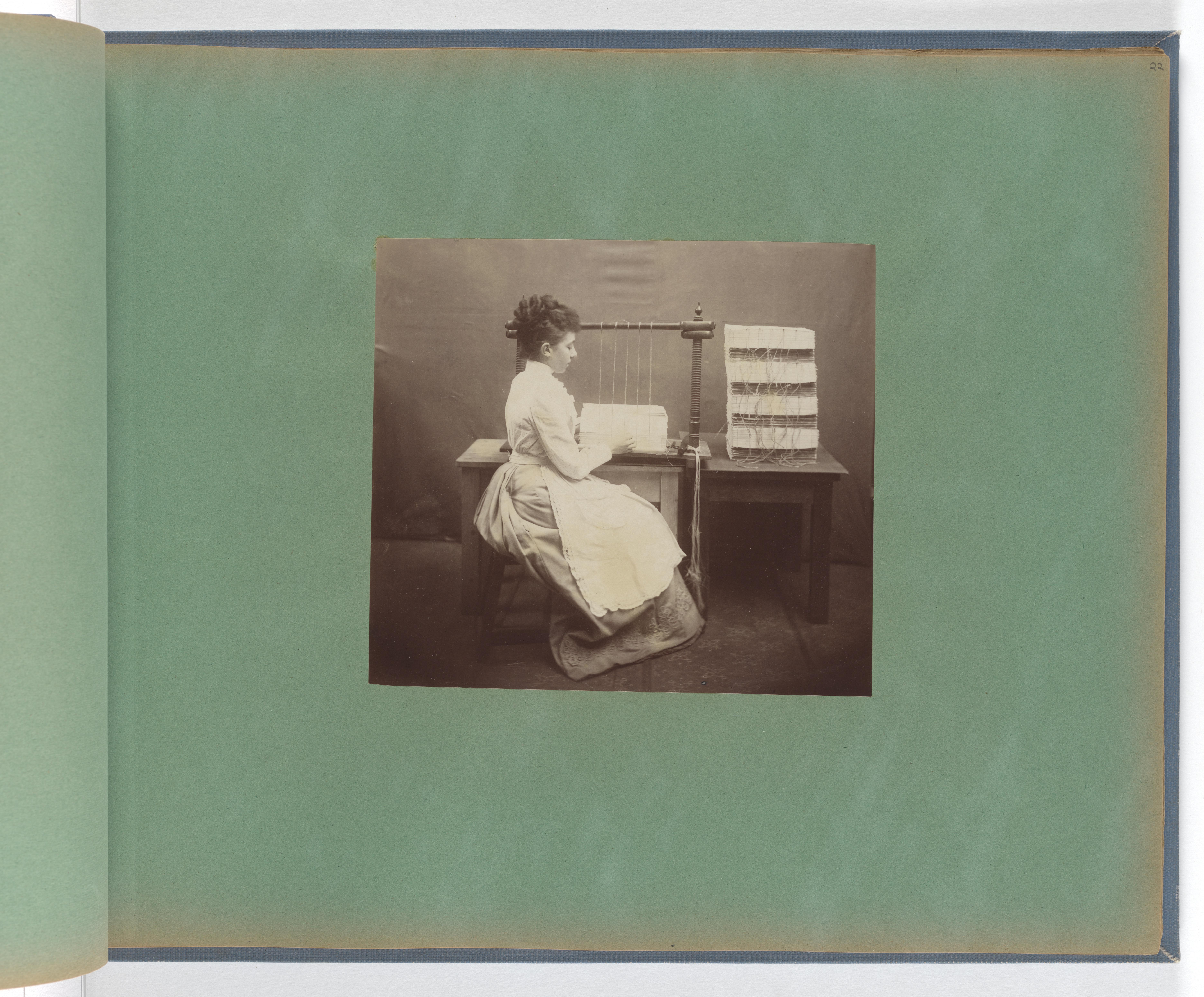I started my career at the Library at the very bottom, literally, in the underground stacks. My main responsibility was collecting and re-shelving items used by readers. Far from being a tedious or repetitious task, I lived it as a succession of introductions to the Library’s vast collection, and then as an ongoing series of quiet rendezvous. I have always loved books for the worlds inside them but the more time I spent among the shelves, the more I became fascinated by the ways those worlds were held and expressed by their exteriors. I needed to know how physical books were made.
My first bookbinding class was a weekend workshop for beginners. Our teacher, Isabelle McGowan, introduced us to bone folders, paper grain, awls and book cloth. Over two days we cut, stitched and glued an armful of little books and a perfect-covered box with lid. It was 18 months later that I returned to class with Isabelle at her bindery in St Peters and became a regular student. Over the years, I have steadily increased my bookbinding vocabulary to include case bindings, endpapers, headbands, kettle stitches, shoulders and hollow backs.
Last year, over two days I sewed and covered my first three-quarter leather and marbled-paper book and finished its spine with decorative embossing. It looked exactly like so many of the old volumes I handle day to day. I felt what I imagine it must be like for a surgeon who, having delved inside the human body for the very first time, looks at the exterior with a new secret knowledge of what it contains.
Isabelle McGowan knew from the age of seven that she wanted to be a bookbinder. A relief teacher at her primary school in Sydney, who happened to be a trained bookbinder, eschewed the curriculum and taught the class to make books instead. ‘She taught us Japanese stab binding, little pamphlet books, concertina books — the same books I now teach beginners,’ she recalls. ‘I got a glimpse into a world where people make books for a living and knew that was what I wanted to do.’
As tertiary study approached, Isabelle knew she would need to go to Europe to immerse herself in bookbinding. She began a fine arts degree at the Edinburgh College of Art, where she explored the freedom of making and honed her aesthetic sense. Halfway through her degree, and with binding still firmly in mind, Isabelle was given the name of a semi-retired, fifth-generation Italian binder who agreed to meet her at his studio, if she could get to Florence. ‘I walked in and all I could see was a sea of finishing tools, beautiful leather, a little marbling set up in the corner and work benches.’ The two said hello and then it was down to business. ‘Make a book with me,’ he said.
Without any previous formal training, Isabelle began making a book alongside this master, folding and sewing the text block, paring the leather, marbling the paper, applying gold to the spine. He was testing her hand skills but, more importantly, her capacity to listen and follow. After three days of working side by side, he agreed: ‘I will teach you as much as you want to learn, as much as I can teach you and as much as we can do together.’ Isabelle trained with this bookbinding master for four years.

Back in Edinburgh, Isabelle opened her own bindery with ten pieces of paper and a giant flower press. ‘From the minute I walked into that little bindery in Florence, I knew I wanted one’, says Isabelle, ‘I knew I wanted to work that way.’ Life as a fine binder who sews, covers and finishes by hand, is a rare profession in today’s mechanised book production industry. But Isabelle met experienced European and English bookbinders who helped cement her skills. She worked in collections where she developed aesthetics that appealed to her — fourteenth-century Dutch stiff board vellum binding, eighteenth-century French binding and the glossy nineteenth-century English bindings with all their gold.
‘One of the biggest influences for me going into historical bindings and repair was the renowned English binder Bernard Middleton. He showed me things about repairing eighteenth-century books, mentored me, added skills.’ One day, walking in the British Library stacks with Bernard, he began intermittently pulling books from the shelves, commenting on and criticising the finishing of various bindings. ‘I thought, wow, he’s a bit tough,’ says Isabelle. ‘It turns out, they were his books.’ Isabelle imagined walking the stacks of the future, picking up her own books.
The most likely place to find a fine binder’s signature is on a book’s cover. In bookbinding, ‘finishing’ refers to the process of decorating the outside of a book. It may include lettering, inlays and tooling, which is embossing intricate designs into leather or cloth, with or without gold leaf. Until the second half of the twentieth century, finishing was done almost exclusively by men who received books sewn and covered. Isabelle is well aware that there have been few women gold finishers through history, and has always wanted to reach that level: ‘That is really what has inspired me and driven my bookbinding.’
The Library’s collection has been touched by several skilled finishers. In 1910, the year the Mitchell Library opened, a bindery was started in a small basement room, staffed by the Government Printing Office. The history of the Mitchell Bindery is a story all of its own, but one of its significant figures was Frank Heyner, appointed as bindery finisher in 1916. Born in London, and son of a well-known binder, he showed early signs of outstanding gifts and, after working and training across Europe, he set sail for Australia.
While the art of hand finishing had long flourished in Australia, Heyner revolutionised a distinctly local type of book or manuscript cover, using Australian wildflowers such as flannel flowers, Christmas bells and wattle. The bound papers of David Scott Mitchell himself are finished using waratahs and banksia leaves. A kangaroo-shaped tool was even cut for the bindery as a mark for volumes bound in kangaroo leather. The Library’s Collection Care branch continues to look after the collection’s bindings and the historic finishing tools, including those made by Paul Souze, a famous French tool cutter whose work Heyner saw when he visited the Paris Exhibition of 1900.
Isabelle McGowan leapt at the opportunity to use the Mitchell Library tools. ‘As a binder, as a gold finisher, you cannot help but love tools and if you see tools that are unusual, absolutely you want to try them, like an artist wants to try a new set of oils.’ She is currently working on a set of bindings using 36 tools selected from the Library’s historic collection. McGowan explains that traditional gold finishing includes a degree of imitation, of tooling according to established proportions and formations. It is a way of walking in the footsteps of the masters. But reusing these old tools in a contemporary context is also a way of drawing the craft forwards, into the present and the future.
I am still a novice student, but bookbinding has already given me that same experience of finding myself in the span of time. These days I am drawn to the books I find in stack not because they are mysterious, but because they are familiar. I am discovering that learning an ancient craft, making a book from scratch, is just a series of steps that human hands still know how to do.
Today, Isabelle's work in the bindery is split between repair and restoration, rebinding and gold finishing, box making and teaching. Teaching is a way of paying respect to those masters who saw enough in her to impart their knowledge. She works hard to make the craft accessible: ‘As humans we need to have the satisfaction of being able to create something by our own hand, and our own mind. To envision something and be able to make it!’ McGowan challenges the aura of nostalgia that often accompanies a specialised craft such as bookbinding when it is described as a ‘dying art’. She teaches with the vigorous optimism that others may want to continue the tradition, but also to impart something of the value that lies in the work. She teaches to develop a community that understands and appreciates fine bindings so that the books she makes might also be found in the personal libraries of the future.
Beyond the object of the book itself, Isabelle helps people access something less tangible. Looking at the very book she made with her Florentine master, she remarks that ‘binding helps us appreciate the little things that appeal to our souls, the feel, the smell, the little touch of gold, how perfectly the tool has come on, the way the paper and the leather meet so beautifully. It’s appreciating life in general, all the little wonders.'
Mathilde de Hauteclocque Librarian, Collection Acquisition and Curation
This story appears in Openbook winter 2023.






